I Never Knew Cochise's Son Looked Like Rock Hudson.
On Earth Day April 22, 1970 a Public Service Video came out on television called "The Crying Indian". What better way to speak about our environment than having a recognized Native American icon actor "Iron Eyes" Cody, a member of the Cherokee Tribe, shed a tear for our planet's environment?
Here is that beautiful Public Service Spot:
https://www.youtube.com/watch?v=j7OHG7tHrNM
The name "Native American" dates back to at least the "French and Indian Wars", but now is used exclusively to describe members of the various Indian Nations living in North America. After the silent movie era the majority of all Hollywood motion pictures portraying "Native American's" started using non-Indian Tribe actors in a big way. Which over the years have included the likes of British born Boris Karloff, Australian actor Michael Pate and Polish American Charles Bronson.
At the time "The Crying Indian" environmental spot was released in 1970. It was widely thought that by using "Iron Eyes" Cody. Whose first motion picture appearance was 40 years earlier, Showed that Hollywood had finally gotten its act together concerning Native Americans and change was finally here. Wishful thinking.
A surprise came to Hollywood and even, sadly, the Native American community who had honored him for his accomplishments. When "Iron Eyes" Cody passed away on January 4, 1999 and his Birth Certificate was revealed. The man who said he was the son of a Cherokee father and a Cree mother was actually Espera Oscar de Corti an Italian American born April 3, 1904 in Kaplan, Louisiana. For 69 years he had scammed the world into believing he was a Native American and once more most sadly the community who believed in him as their most visible representative.
Looking again at the year 1970 when "The Crying Indian" video was released to so much praise. We find the counter point in Ralph Nelson's "Soldier Blue" released on August 12th. The film was advertised as telling the true story of "The Sand Creek massacre".
However, the motion picture was not based upon that actual event, but a novel "Arrow in the Sun" by Theodore V, Olsen that would be renamed "Solider Blue" after the movies release and Olsen had co-written the screenplay.
Olsen's original novel's story is described on Amazon:
Young soldier Honus Gant and beautiful Cresta Lee are the only survivors of a wagon train, and Gant must protect Cresta, a former Native American captive, from the legendary Cheyenne chieftain, Spotted Wolf, once Cresta's husband.There is nothing about Sand Creek in Olsen's original work. The "Sand Creek massacre" occurred on November 29, 1864. When a 700 man force of Colorado militia raided and destroyed a peaceful Cheyenne and Arapho village. In which 2/3rd's were women and children and the majority of the other third old men well beyond fighting age. The estimated death toll was between 70 and 163 Indians.
Below are some of the advertising material for "Soldier Blue". Note that one of the posters has a somewhat sexual image of a young naked Indian girl's back being used to promote Ralph Nelson's alleged plight of the American Indian:
Nelson's motion picture begins with his recreation of what he tells his viewers are the true events at Sand Creek. As the one poster seems to indicate. Ralph Nelson also felt it was necessary for the Indian women to be seen totally naked including full frontal nudity to make his argument against the Union Army. After all the on screen brutality and raping of the first minutes of the motion picture. Nelson suddenly changes direction and reverts to the simple plot line of Honus Gant played by Peter Strauss protecting Cresta Lee portrayed by Candice Bergan against her ex-Cheyenne Husband Spotted Wolf from the original source novel .
It should also be noted that Ralph Nelson after making a major promotional blitz about the movie portraying what truly happened to the Cheyenne and Arapho at Sand Creek. Has the critical role of Spotted Wolf played not by a Cheyenne, or Arapho actor. Not even another Native American actor, but Mexican actor Jorge Rivero. The only other major Indian role in his motion picture was also portrayed by a Mexican actor named Jorge Russek. Further the film was entirely shot in Mexico and the women and children seen in the opening are also Mexican not Native American.

British film critic P.B. Hurt on the website Cinema Retro wrote:
A good number of critics in 1970 believed that Soldier Blue had set a new mark in cinematic violence, as a result of its graphic scenes of Cheyenne women and children being slaughtered, and had thus lived up – or down – to its U.S. poster boast that it was "The Most Savage Film in History." A massive hit in Great Britain and much of the rest of the world, Soldier Blue was, in the words of its maverick director, Ralph Nelson, "not a popular success" in the United States. This probably had less to do with the picture's groundbreaking violence, and more to do with the fact that it was the U.S. Cavalry who were breaking new ground. For Nelson's portrayal of the boys in blue as blood crazed maniacs, who blow children's brains out and behead women, shattered for ever one of America's most enduring movie myths – that of the cavalry as good guys riding to the rescue – and rendered Soldier Blue one of the most radical films in the history of American cinema. The film's failure in its homeland might also have had something to do with the perception in some quarters – prompted by production company publicity material – that it was a deliberate Vietnam allegory.http://www.cinemaretro.com/index.php?/archives/1840-THE-MOST-SAVAGE-FILM-RELIVING-SOLDIER-BLUE.html
I remember comments at the time that specially Ralph Nelson had turned the Cheyenne/Arapaho massacre at "Sand Creek" into an allegory of the "My Lai Massacre" led by Lieutenant William Calley, Jr. It would seem that Nelson used a Native American tragedy for his own purposes that really had nothing to do with the people's shown..
From an article by Clay Upton entitled: Stereotyping Indians in Films"
Even before the movies had sound added to them, the Native Americans in films had been stereotyped. They were always shown with scowls, while wearing war paint, showing that they were ready to kill at any time, or that they were less than the whites and that the Indians had need to be helped with everything having to do with the white way of life. It is through these early silent films and short stories, such as Sioux Ghost Dance (1894), Buck Dance (1898) and many others just like them that the stereotypes of Indians were shown to the rest of the nation. The people who were going to the movies, mainly the poor, immigrants, and rural dwellers, were going mainly to escape their own lives, to jump into a world that was completely outside of their own comfort zone and to experience things that they more than likely would never be able to experience in their lifetimes. These people mostly had no experience or knowledge of how an Indian looked or acted so they had nothing to compare the images that they were seeing on the screen with; they just accepted the image as true. Movies during this time were very influential social agents because the movies were being shown on the same screens that the news reels of the time were being shown on; therefore, through the way that these early movies portrayed Native Americans, people believed that they were seeing an authentic Native American, or the “real” Indian that they had heard all of the stories about.This link is to that circa 1894 short of 24 seconds entitled "Sioux Ghost Dance" mentioned above.
https://www.youtube.com/watch?v=rU6a7S1YHLQ
Born in Canada on September 20, 1855 was Elijah Tahamont. Tahamont was a chief of the Abenaki, of the Algonquin tribe. He was known as "Dark Cloud" and under that name he would become a silent film actor.

The budding film industry was located in New York and New Jersey. Dark Cloud in 1910 worked for both "American Mutoscope" and "Biograph" under the direction of D.W. Griffith. One of the films he appeared in was a 17 minute short "The Song of the Wildwood Flute" co-starring with Mary Pickford who played "Dove Eyes". Dark Cloud starred as "Gray Cloud".
He played Chingachgook in the 1911 film "The Last of the Mohicans" which may be the earliest movie version of James Fenimore Cooper's novel. It was directed by James Cruz who would also directed 1923's "The Covered Wagon".
Dark Cloud moved with Griffith to Hollywood and continued to make a total of 34 pictures. Sadly he became ill during the "Spanish Flu" pandemic of 1918 and died in Los Angeles.
The link below is to "The Dallas Morning News" about the recent discovery of a silent film shot in Oklahoma with an all Indian cast including the son and daughter of famed Chief Quanah Parker called "The Daughter of Dawn".
On the page is a six minute video about the movies discovery with scenes from the film. The short video is a must for anyone interested in portrayal's of Native American's in motion pictures.
http://www.dallasnews.com/news/state/headlines/20150429-rare-silent-film-featuring-native-american-cast-customs-screens-decades-after-surviving-dallas-fire.ece
The 1923 motion picture "The Covered Wagon" is the first film that future actor and Indian historian Tim McCoy assisted by providing Native American actors. There were no non-Native American's used in the motion picture. McCoy after filming was asked to bring some of his Indians back to Hollywood for the film's premiere which he did.
Here is a link to a Laser Disk transfer of "The Covered Wagon".
https://www.youtube.com/watch?v=8e5_xGdAOIo
Saturday Afternoon's during 1952 in Los Angeles. Local television station KTLA Channel 5 ran a special program with Tim McCoy for children. I was 5 years of age when it started. McCoy educated young viewers on Indian customs and history. Along with playing one of his motion pictures. His co-host was "Iron Eyes" Cody. To my knowledge this may have been the only show anywhere in the country actually telling the true stories about Native American's to children, or for that matter grown ups.
On August 28, 1924 director John Ford's "The Iron Horse" about the building of the railroad was released. Once more Tim McCoy provided the Indians for the prologue to the motion picture.
Here is a link to John Ford's motion picture which set the example of how an Indian attack on the railroad would look in future feature films.
https://www.youtube.com/watch?v=Z4YP_z3dR3g
In the middle of this three shot, below from Ford's motion picture, is Chief John Big Tree. His film career began in 1915 in a silent short entitled "Author! Author!" in the part of Peter Lone Wolf and ended with director Anthony Mann's "Devil's Doorway" as "Thundercloud" released September 15, 1950. Over that 35 year period he would appear in 59 motion pictures.
Born Isaac Johnny John on June 2, 1877 in the Seneca Nation. Chief John Big Tree was a witness to how Hollywood portrayed Native American's throughout his life. He also was part of the John Ford acting company and therefore had a different opinion of the director than even some of his biographers today.
In 1930 Chief John Big Tree appeared with "Iron Eyes" Cody in Raul Walsh's 70mm "The Big Trail". Starring a one time prop boy Marian Morrison that Walsh had just renamed John Wayne after Revolutionary War General "Mad Anthony Wayne", because Walsh just happened to be reading a book about the general at the time. True story.
Besides "Iron Eyes" Cody and Chief John Big Tree there was one other Indian actor in the motion picture. He needs to be mentioned, because of who he was in itself makes the fact he became an actor even for a short period of time very interesting.
Nino Cochise had been born on the Chiricahua Apache Reservation in Arizona February 20, 1874. He would appear in 7 motion pictures including Douglas Fairbanks' "Robin Hood" and "The Black Pirate" prior to his small role in "The Big Trail". He was also the Grandson of the legendary Chirichahua Apache chief Cochise and would become the primary Chief of the tribe himself. After a very long life Nino Cochise would die at the age of 110 in 1984. Of note in the title for this article is the mention that Rock Hudson would play his father in a Universal motion picture and I will cover that shortly.
Returning to Chief John Big Tree. He apparently was the only Native American in the entire cast of the 1932 version of "The Last of the Mohicans" which starred Harry Carey. His role was of a Huron warrior. While the major role of Chingachgook was played by Hobart Bosworth, Uncas by Frank Coghlan, Jr. and Magua by Bob Kortman. Four years later in the 1936 version nothing had changed and besides other non-Native American actors. Actor Bruce Cabot would play Magua. Cabot would always be known for the role of John Driscoll in the 1933 'King Kong".
Chief John Big Tree was in John Ford's 1939 classic "Stagecoach" as an Indian Scout.
He would also appear, below, in John Ford's 1939 "Drums Along the Mohawk" as "Blue Black" in a minor, but significant role.
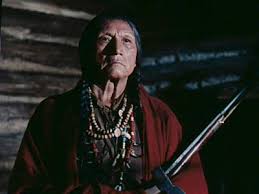

Chief John Big Tree made appearances in Cecil B. DeMille's 1940 motion picture "North West Mounted Police" as "Blue Owl" and DeMIlle's "Unconquered" as an "Indian"., Both roles without screen credit. While receiving on the screen credit for "Unconquered" went to "Iron Eyes" Cody as "Red Corn" and British born Boris Karloff as "Cuyasuta-Chief of the Seneca's". Which is interesting when you think DeMille had a real Seneca Chief in his cast who received no screen acknowledgement.
Chief Big Tree was in Fritz Lang's "Western Union" as Chief Spotted Horse, but perhaps he is best known for once again working with John Ford. The film was the middle piece of Ford's Calvary Trilogy "She Wore A Yellow Ribbon", Chief John Big Tree played Nathan Brittles, John Wayne's, old friend "Pony That Walks".

Chief John Big Trees died on July 6, 1967 at the age of 90.
When mentioning the motion picture "She Wore A Yellow Ribbon". There is another memorable Indian role that stays in viewers mind and that is of the War Chief "Red Shirt".
.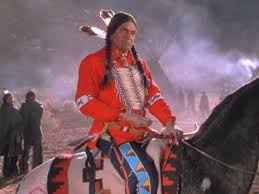
The problem of course was the actor playing the part was not Native American, but an Afro-American actor named Noble Johnson. Who like Bruce Cabot is remembered more for his role as the Native Chief of Skull Island in the 1933 "King Kong". For those who might be interested in this actor's career. In which he played more Indian roles than most Native American actors during his life. Here is a link to my blog article about this distinguished and forgotten actor:
http://kinescopedreams.blogspot.com/2015/06/noble-johnson-african-american-pioneer.html
John Ford was accused over and over again about his "racist" portrayal's of Native Americans. In 1964 what some consider his attempted apology was released on October 3rd. The movie was meant to tell the factual story of the "Northern Cheyenne Exodus of 1878 to 1879". Ford and his son Patrick had written a treatment back in 1957 with plans of making it a docudrama with an all Indian cast. However, Hollywood got into the act and the final motion picture was anything but a docudrama. The motion picture was "Cheyenne Autumn".
.

Ford had wanted Mexican/American actor Anthony Quinn to play the role of "Dull Knife" sighting that his mother was half Cherokee. He wanted Richard Boone to play "Little Wolf". Boone, Ford said, also had Indian blood in him. As Richard Boone's mother was Jewish whose family came from Russia. Whatever amount of "Indian blood" the actor had in him came from his father Kirk E. Boone. A distant relative of one of the brothers of Frontiersmen Daniel Boone. Ford's other choice was character actor Woody Strode. There was no question about Strode's ancestry. His father was Creek-Black Foot and his mother Cherokee. Both "Freed Slaves" who had been adopted into their respective tribes, before their marriage.
However, Hollywood who knew better did not want any of John Ford's semi-Native American actors.
Woody Strode's life is very interesting and he would play Native American's in films. You can read about him and the Australian actor Michael Pate I previously mentioned through this link to another article on my blog:
http://kinescopedreams.blogspot.com/2015/03/woody-strode-and-michael-pate-one.html
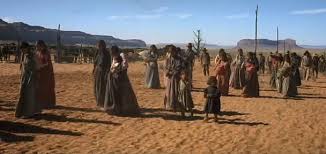
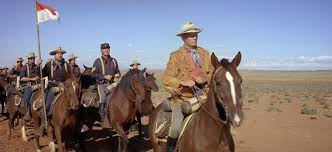
Instead of Ford's choices for the leading Native American roles. The powers to be cast Luis Antonio Damaso de Alonso the son of Mexican parents without Indian blood and better known as Gilbert Roland as "Dull Knife", Ricardo Gonzalo Pedro Montalban y Merino the son of immigrants to Mexico from Spain and also without any Indian blood and better known as Ricardo Montalban played "Little Wolf".
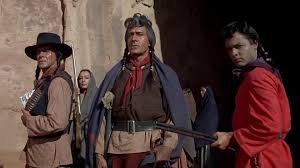
Continuing to destroy Ford's original ideas of either an all Indian cast, or actors with Native American blood in them. The casting directors for Warner Brothers continued by placing Victor Jory the Canadian born actor of American parents as "Tall Tree",
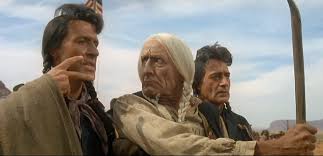
Also cast was Maria de los Dolores Asunsolo Lopez-Negrete better known simply as Dolores del Rio. Whose Mexican parents were also anything but Indian. Her father was a wealthy farmer and head of the Bank of Durango and her mother was descended from a family of very high lineage. Dolores Del Rio would play "Spanish Women".
.

Playing the young brave "Red Shirt" was a very obviously non-Native American in Sal Mino the son of Italian coffin makers from the Bronx. Although to be fair to Mino. He did play "White Bull" the young Sioux Brave in Walt Disney's movie "Tonka" about the horse "Comanche" that survived "The Little Big Horn". So he had previous acting experience playing a Native American character/


These actors then were the lead members of the Cheyenne for this "Factual" motion picture.
Then there were the rest of the Cheyenne's who according to the script would speak mostly their native language. The actual journey went from the Oklahoma Territory to the Cheyenne's home in Wyoming. However, as with most of John Ford's motion pictures this one was shot in Monument Valley, Utah and that meant the Native American extra's were Navajo.
As a result all of the Cheyenne dialogue was in Navajo and White audiences could care less as they didn't know better, but the Cheyenne did. Additionally, as the Navajo performers knew almost nobody else on the set understood them. The actual Cheyenne dialogue written for the film was changed to some very raunchy jokes including one about Richard Widmark's lower anatomy. However the motion picture has remained a big hit among Navajo communities who can translate the Navajo/Sioux.
The critical reviews were mixed on the motion picture. Something unexpected at the time the film was made and released has occurred over time, because of that ribald and crude language used by the Navajo extra's. Academics of Indian Studies across the country point to those choice words as an historic moment in time. When the Native American community was first able to poke fun at mainstream White Hollywood's historical interpretation of the American West, if this is true it is a sad commentary in itself.. I will let my readers make up their own minds on that subject.
Going back 14 years to 1950 to the family of Native American actor and Chief of the Chirichaua Apache Nino Cochiise. The motion picture was "Broken Arrow" based upon the novel "Blood Brothers" by Elliott Arnold. The novel was a fictionalized story about the relationship between Chirichaua Apache Chief Cochise and Indian Agent Tom Jeffords.
Playing Tom Jeffords was James Stewart and playing Cochise was Jeff Chandler. Who would be nominated for a Best Supporting Actor Academy Award. He was a Jewish American actor born in Brooklyn who became one of the best known Universal Actors of the 1950's, but is remembered primarily for the role of Cochise over all others. Although this initial movie was made by 20th Century Fox.
.
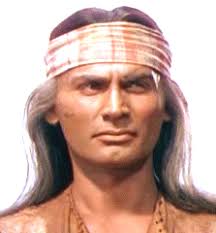
The love interest for 41 year old Stewart was 15 year old Debra Paget as "Sonseeahray (Morningstar)". Paget was born in Denver, Colorado and would be remembered for her role as "Lillia the Water Girl" in Cecil B. DeMille's 1956 "The Ten Commandments" that both Vincent Price and Edward G. Robinson would fight John Derek as Joshua over.
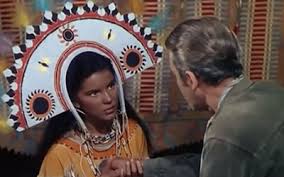
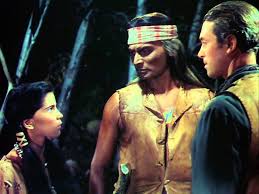
The motion picture attempted a realistic look at Apache life including the girl's puberty ceremony and the wedding ceremony. The film employed 240 members of the Fort Apache Indian Reservation as extras to add authenticity. However, it was decided that the characters would all speak proper English to avoid the broken-English normally employed for Native Americans in Hollywood Motion Pictures.
The "Broken Arrow" also broke from Hollywood custom by portraying the Apache's in a sympathetic point of view instead of the hostile and violent portrayals of most films toward White settlers. What conflict exists in the film is between Jeffords and the town people over the Indian Agent attempting to make a Peace Treaty with Cochise and within the tribe with Geronimo played by Jay Silverheels.
With the success of "Broken Arrow" it was followed by a sequel "The Battle at Apache Pass" made this time by Universal International. Jeff Chandler returned as Cochise and Jay Silverheels as Geronimo. However, actor John Lund playing Calvary Major Cotton got top billing.

Once again Hollywood turns actual events into fiction. The film was based upon two major incidents in the history of the Apache Nation. The first was "The Bascom Affair" which started the 1860's Apache War. A group of "Tonto Apache's raided a White settlers home and took his son. The U.S. Calvary under Lieutenant George Nicholas Bascom got it wrong and went after the Chiricahua Apache's under Cochise, because the raiders were seen heading west toward the Chiricahua mountains. The incident is mention in the motion picture "Broken Arrow". In this movie the time line is changed as "The Bascom Affair" took place in 1861 and "The Battle at Apache Pass" in 1862. When Native American's for the first time came under the fire of artillery.
The Calvary involved in the battle actually came to the Arizona Territory from California to clean out Confederate strong holds. My reader must remember that the Civil War was in progress at this time. A fact most motion pictures would ignore if they fell within that time period except when they involved Confederate Troops such as "Major Dundee". In that motion picture Sam Peckinpah threw in both Apache;s with the chief played by Australian Michael Pate and French troops. When Union Officer Dundee is seen crossing into Mexico the country was under Maximilian's rule. Another historical event that was going on during the period of "The Battle at Apache Pass"
.
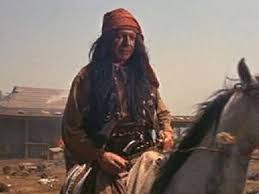
Above Michael Pate in Major Dundee.
The basic battle took place over a spring being held by the Apache's position and the Union Solider's under Captain Thomas L. Roberts needed. Initially the artillery fire was useless as they were shooting up hill. Roberts was under fire from an estimated 300 to 400 Apache warriors Even so Roberts was still able to move the artillery into a more effective position. The Apache's held the pass until nightfall and then left giving Roberts' men the much needed water.

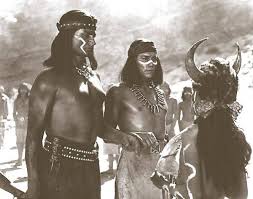
In the motion picture a secondary climax comes when Geronimo accuses Cochise of being a weak leader and the two fight. Cochise wins and banishes Geronino from the tribe forever,
Here is a link to the motion picture for my readers enjoyment:
https://www.youtube.com/watch?v=OFofiQvVth0
I now come to a 3-D motion picture from 1954 starring Rock Hudson as Nino Cochise's father. The title is simply "Taza, Son of Cochise".

To tie the picture to the first two films. Jeff Chandler has a cameo as Cochise on his death bed.
Basically this piece of fiction tells of the battle for control of the tribe, It is between Taza who thinks like his father and his brother Naiche who wants the old ways and war with the whites. Added to this is a different battle with the father of Oona the women Taza's loves. Her father agrees with Naiche and therefore will not permit the marriage.
Now to that Native American (?) cast which would be mostly known for some memorable 1950's Science Fiction movies.
Playing Taza was of course Rock Hudson born in Winnieka, Illinois and definitely not Native American.
Playing Oona was Barbara Rush born in Denver, Colorado and graduate of the Pasadena Playhouse outside of Los Angles. Who had just starred in the science fiction film "It Came from Outer Space" and previous was in the 1951 Oscar winning "When Worlds Collide"..
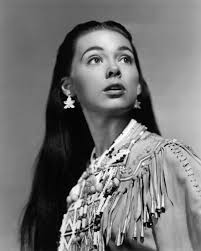
Playing Naiche was Rex Reason, an American actor born in Berlin in 1928, who would be seen in two classic Universal Science Fiction films "This Island Earth" and "Revenge of the Creature".

Playing Oona's father was Morris Ankrum who would also be known for Science Fiction films such as the original "Invaders from Mars", "The Giant Claw", "Earth vs the Flying Saucers" and several others.
Playing Geronimo was actor Ian MacDonald best known to Western fans as Frank Miller in "High Noon". This is MacDonald from "High Noon" as there was no picture of him from this movie available to me.
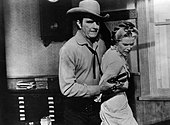
In fact there wasn't one part in the entire motion picture played by a Native American and that included the extras.
Although this trilogy attempted. even with non-Native American actors, to portray the Apache as he really was there were still many other Westerns motion pictures of the time that played the Indian as the savage. It is probably appropriate to mention why there seemed to be so many Westerns being made in the early 1950's. Western movies were simply considered "SAFE".
In Washington D.C. thanks to Senator Joseph McCarthy, like minded thinkers and the "House Committee on Unamerican Activities" were working overtime to rid the country of Communists and Communist sympathizers. Those in the motion picture industry were being hit on two fronts. The first the committee itself and the second the industry itself who wanted to be ahead of the committee.
At this time it was deemed "Safe" to make three kinds of movies: Westerns, Science Fiction and Biblical. Westerns reflected America's past, if not imperfect. Science Fiction was pure fantasy and even could be used to promote anti-communist themes such as "Invasion U.S.A." and "The Red Planet Mars". As for the last no communist would come near the Bible even if it was a screenplay by Cecil B. DeMille and full of sex.
Another factor against Native American's in the early 1950's seems funny today and wasn't even considered at the time, but was related to "Taza, Son of Cochise". It was the film's process 3-D also being used for horror and science fiction films like "House of Wax" and "GOG". Audiences were having the illusion of things flying off the screen directly into their faces. The process was perfect for Westerns were you could have the Indian arrows shot directly at the person in the last row and send them ducking. How about a flaming arrow first coming directly at your face before landing on top of the roof of a homesteaders house. Then from inside watching the flames burn the ceiling while the timbers fall on you or seem too. Some Western titles were: "Hondo" with John Wayne in a knife fight were the blade comes off the screen, or "The Charge at Feather River" with the Indian arrows and spears flying off the screen/ "Fort Ti" had those burning arrows I mentioned. As I said this seems funny looking back today, but raids by savage Indians worked very well while I was growing up in a 3-D motion picture.

Look at the depth of field on these shots from "Hondo" and you can imagine how they were in 3-D. In the one of the left the fence post is across the audience and on the right John Wayne walks from a distance right into your face.
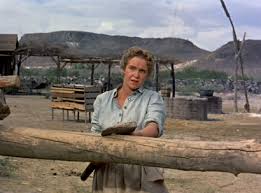


Going off Motion Picture and Television for a moment, but a point to make here. With the early 1950's the 3-D craze went to comic books which my friends and I bought. They were higher in price, but came with 3-D Glasses. Here are a few examples that also effected a person's view of Indians.



At the same time for only 10 cents we could buy non-3-D comics which still didn't help the Native American image.
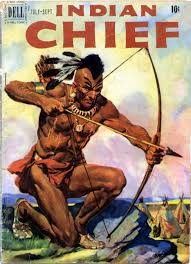
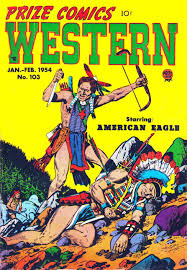
However, on television there was Tonto and "The Lone Ranger" which would run from 1949 through 1957. The show had Clayton Moore, or John Hart as the man in the mask with the silver bullets. Then there was Jay Silverheels as Tonto his "faithful Indian companion". The opposite of his role as Geronimo. Moore and Silverheels would also appear in two movies: 1956's "The Lone Ranger" and 1958's "The Lone Ranger and the Lost City of Gold". The program treated Tonto as the equal to the white Lone Ranger and that included in intelligence. A very positive Native American character.

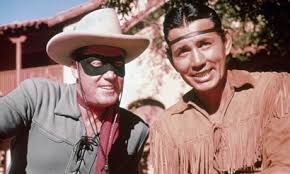
Jay Silverheels was born Harold John Smith on May 26, 1912 in the Six Nations of the Grand River Nation near Toronto, Canada and was Mohawk. He passed away on March 5, 1980.
Contrary to some "The Lone Ranger" wasn't the only television show to project a positive image of the Native American, but probably the only one starring a real Native American.
On September 25, 1956 a 30 minutes program called "Broken Arrow" based upon the 1950 motion picture premiered. Playing the role of Tom Jeffords was John Lupton and Michael Ansara played Cochise. Ansara was born in Lebanon, but was Syrian. Italian American Actor Anthony Caruso appeared as Geronimo. The series would last two years until September 23, 1958 with its 73rd episode
.


Michael Ansara returned to television as an Apache U.S. Marshall with a Harvard Education in "The Law of the Plainsman". The background story was a two part episode of Chuck Connor's "The Rifleman". Ansara as Sam Buckhardt had saved a Calvary officer after an Indian attack and when the officer died he left Sam money. It was with that money that he educated himself including Harvard. The series ran only one season and it was definitely the idea of an Indian in the primary role which impacted viewership at the time.

Released March 13, 1956 was John Ford's "The Searchers" set just after the Civil War. It tells about a Comanche raid on the family of the brother of Ethan Edwards played by John Wayne and the kidnapping of his two young nieces. The elder girl is found raped and murdered. What then fellows is Ethan's obsessive search to find the youngest. Who if still alive he must kill, because as years pass in the motion picture Debbie must now be the wife of an Indian, but when he finally meets her in the climatic sequence a change comes over Ethan toward the young girl.
The film can be said to be very anti-Native American, but through the relationship between Jeffery Hunter's Martin Pawley and Beulah Archueletta's "Wild Goose Flying in the Night" aka: "Look" a side of frontier and Indian life not always portrayed is honestly shown.
On November 25, 2001 Film Critic Roger Ebbert looking back at the motion picture remarked:


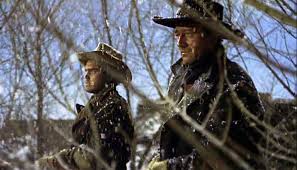

According to author Glenn Frankel in his book "The Searchers: The Making of an American Legend". The actual incident that novelist Alan LeMay based his original novel upon. Happened before the Civil War and was the kidnapping in 1836 East Texas of 9 year old Cynthia Ann Parker by a Comanche raiding party.The original series of searches for her and other taken family members from the raid ended in failure/ However, 24 years after her capture members of the Texas Rangers and U.S. Calvary raided a Comanche village and found 33 year old Cythia Ann Parker with her children and "restored her" to proper Texas society.
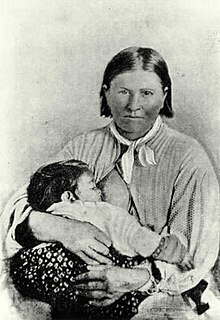
Above Cynthia Ann Parker with her daughter.
Cynthia's Comanche husband was Peta Noconna of the Quahadi band who was also apparently the leader of the original raid.

Below is Cynthia Ann Parker and Peta Noconna;s son the progressive Comanche Chief Quanah Parker whom I mentioned before.

As previously mentioned Cynthia Ann Parker's grandchildren appeared in the newly discovered 1920 silent film "The Daughter of Dawn".
More scenes from "The Searchers"

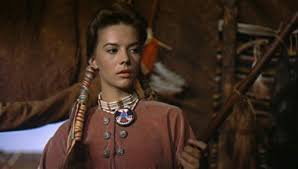
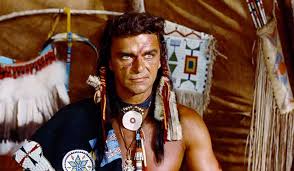

The flip side of the novel "The Searchers" and John Ford's motion picture was a film from John Huston. 1960's "The Unforgiven" starred Burt Lancaster, Audrey Hepburn, Audie Murphy, Lilian Gish and Doug McClure as a family living on the Texas frontier. What the mother's three son's don't know is she hides a secret about their sister. This comes out when an Indian brave shows up asking to see his sister played by Hepburn. Whom all three brothers have been led to believe is their naturally born sister. Even Lancaster the elder of the three was too young to realize what was really going on when "Rachel" was born.
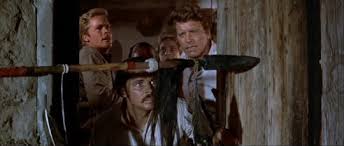



Hepburn's "Rachel" is actually a Kiowa child saved on a raid against them by the brother's father.
The film tackles the issue of racism on the frontier against the Kiowa and toward people of mixed blood.
The film has been accused of demonizing Native Americans, but I think whomever feels that way has Huston wrong. Through Audie Murphy's character of Cash Zachary John Huston hits bigotry straight on in 1960's America. It isn't the Native American's that are the problem in this movie, but all the White settlers and their lack of understanding of the Kiowa. Yes, the Kiowa's attack the family to get "Lost Birds" sister, but it is after many attempts to peacefully bring her to the tribe and he is now blinded with frustration on his part. Yes, "Lost Bird"s not understanding how she considers herself "white" not "Indian" needed to be considered by him. So that point works both ways. It could also be argued that Huston was not really thinking about Native American's, but Negro's the year the picture came out and he turns the Kiowa's into an allegorical representation of all races in the United States at the time experiencing discrimination. The may very well be true, but does that equate to "demonetization" of Native Americans?
Four years before he made "Soldier Blue" Ralph Nelson made "Duel at Diablo" based upon the novel "Apache Rising" by Marvin H. Albert who co-wrote the screenplay. .James Garner plays an Army Scout who was "married" as he states clearly to a "Comanche Wife". She is murdered and and he is seeking revenge against the white's who did this for the reward money offered on Indian scalps.
Crossing a desert area Garner's Jess Remberg spots a women played by Swedish actress Bibi Andersson being chased by Apache warriors. He rescues Ellen Grange and takes her back to town and her shop keeper husband played by Dennis Weaver/

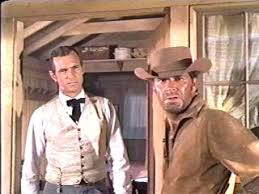
As with presenting James Garner's character as a man of the West who fell in love and married an Indian maiden through a Comanche ceremony. Ellen Grange is another twist to the normal Calvary vs Native American scenario. She was taken captive by the Apache's and had the Grandson of the tribe's leader Chato. Her husband died and now so must be buried with him. Ellen is faced with discrimination on two sides. The townspeople who look down on her for having an Indian child and coming back and the Indians who look down on her for not following their ways.

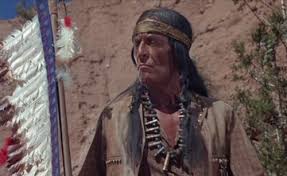
Added to this scenario is an over zealous young Calvary officer Lieutenant McAllister who wants to make a name for himself and advance in rank at any cost.
All three elements come together in the box canyon called "Diablo". As the Apache's under Chato confront McAllister's inexperienced troops he has taken against them. As Remberg discovers it is Ellen Grange's own husband who killed his wife and he is present with the troops. As Chato realizes his grandson is with the soldiers and is confronted with the problem of not injuring him, or Ellen Grange.
It seems that when a movie has to do with Indians it is generically tagged a "Western". One exception are the versions of James Fenimore Cooper's "The Last of the Mohicans" that become "historical drama", or a "period piece". One such period piece starred Lex Barker and Lon Chaney in the title role in "The Battles of Chief Pontiac". This 1952 film supposedly tells the story of the Ottawa's under Pontiac and their battle with the British. There is also the treachery of a Hussein Officer who sends the Ottawa's blankets with small pox. A factual event as are some parts of this 72 minute long motion picture.
At the time of the movie was released film critic Hans J. Wolstein wrote:




There were three main motion pictures about Osceloa and the Seminole Wars in Florida made during the 1950's. Two very fictionalized and the other based mostly upon fact.
The first film was from 1951 and starred Gary Cooper entitled "Distant Drums". The film is described as a "FLORIDA WESTERN". So I guess the other two films I will mention are also "Florida Westerns".

This was a major production for Warner Brothers directed by Raul Walsh. The film would have a full blown "World Premier" in New York City on Christmas Day 1951.
Here is an excerpt from a Turner Classic Movie review of the motion picture:
My reader will note that the TCM review states that Chief Osceola was imprisoned during the second Seminole war. What it does not say is that he died in prison. While in this motion his substitute "Ocala" dies in a knife fight underwater with Gary Cooper. Another example with Hollywood looking for a more glamorous way to end a real person's life than history.


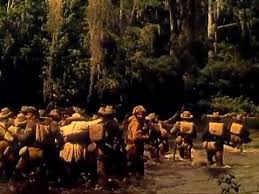
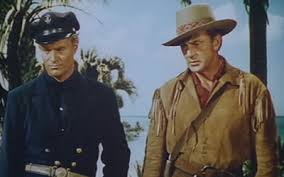
Rock Hudson starred as Army Lieutenant Lance Caldwell in the 1953 motion picture "Seminole" that was also pure fiction. Playing his boyhood friend "Osceloa" was Anthony Queen. While Barbara Hale played the girl they both loved. Hugh O'Brien played Kajeck Osceloa's second in command and the villain of the piece was played by Richard Carlson as Major Harlan Degan.

The plot has Rock Hudson telling the story in flashback as he stands trial for the death of a sentry. Richard Carlson is an obsessed commanding officer who goes strictly by the book. A story line played out many times before. When chasing Osceloa into the Everglades which only Hudson, being from Florida, really knows. Carlson makes his troops keep their high collared uniforms buttoned up the neck. The men start to fall from heat stroke and of course Carlson never manages to find Osceloa, or the Seminoles.
Chief John Big Tree made appearances in Cecil B. DeMille's 1940 motion picture "North West Mounted Police" as "Blue Owl" and DeMIlle's "Unconquered" as an "Indian"., Both roles without screen credit. While receiving on the screen credit for "Unconquered" went to "Iron Eyes" Cody as "Red Corn" and British born Boris Karloff as "Cuyasuta-Chief of the Seneca's". Which is interesting when you think DeMille had a real Seneca Chief in his cast who received no screen acknowledgement.
Chief Big Tree was in Fritz Lang's "Western Union" as Chief Spotted Horse, but perhaps he is best known for once again working with John Ford. The film was the middle piece of Ford's Calvary Trilogy "She Wore A Yellow Ribbon", Chief John Big Tree played Nathan Brittles, John Wayne's, old friend "Pony That Walks".
Chief John Big Trees died on July 6, 1967 at the age of 90.
When mentioning the motion picture "She Wore A Yellow Ribbon". There is another memorable Indian role that stays in viewers mind and that is of the War Chief "Red Shirt".
.
The problem of course was the actor playing the part was not Native American, but an Afro-American actor named Noble Johnson. Who like Bruce Cabot is remembered more for his role as the Native Chief of Skull Island in the 1933 "King Kong". For those who might be interested in this actor's career. In which he played more Indian roles than most Native American actors during his life. Here is a link to my blog article about this distinguished and forgotten actor:
http://kinescopedreams.blogspot.com/2015/06/noble-johnson-african-american-pioneer.html
John Ford was accused over and over again about his "racist" portrayal's of Native Americans. In 1964 what some consider his attempted apology was released on October 3rd. The movie was meant to tell the factual story of the "Northern Cheyenne Exodus of 1878 to 1879". Ford and his son Patrick had written a treatment back in 1957 with plans of making it a docudrama with an all Indian cast. However, Hollywood got into the act and the final motion picture was anything but a docudrama. The motion picture was "Cheyenne Autumn".
.
Ford had wanted Mexican/American actor Anthony Quinn to play the role of "Dull Knife" sighting that his mother was half Cherokee. He wanted Richard Boone to play "Little Wolf". Boone, Ford said, also had Indian blood in him. As Richard Boone's mother was Jewish whose family came from Russia. Whatever amount of "Indian blood" the actor had in him came from his father Kirk E. Boone. A distant relative of one of the brothers of Frontiersmen Daniel Boone. Ford's other choice was character actor Woody Strode. There was no question about Strode's ancestry. His father was Creek-Black Foot and his mother Cherokee. Both "Freed Slaves" who had been adopted into their respective tribes, before their marriage.
However, Hollywood who knew better did not want any of John Ford's semi-Native American actors.
Woody Strode's life is very interesting and he would play Native American's in films. You can read about him and the Australian actor Michael Pate I previously mentioned through this link to another article on my blog:
http://kinescopedreams.blogspot.com/2015/03/woody-strode-and-michael-pate-one.html
Instead of Ford's choices for the leading Native American roles. The powers to be cast Luis Antonio Damaso de Alonso the son of Mexican parents without Indian blood and better known as Gilbert Roland as "Dull Knife", Ricardo Gonzalo Pedro Montalban y Merino the son of immigrants to Mexico from Spain and also without any Indian blood and better known as Ricardo Montalban played "Little Wolf".
Continuing to destroy Ford's original ideas of either an all Indian cast, or actors with Native American blood in them. The casting directors for Warner Brothers continued by placing Victor Jory the Canadian born actor of American parents as "Tall Tree",
Also cast was Maria de los Dolores Asunsolo Lopez-Negrete better known simply as Dolores del Rio. Whose Mexican parents were also anything but Indian. Her father was a wealthy farmer and head of the Bank of Durango and her mother was descended from a family of very high lineage. Dolores Del Rio would play "Spanish Women".
.
Playing the young brave "Red Shirt" was a very obviously non-Native American in Sal Mino the son of Italian coffin makers from the Bronx. Although to be fair to Mino. He did play "White Bull" the young Sioux Brave in Walt Disney's movie "Tonka" about the horse "Comanche" that survived "The Little Big Horn". So he had previous acting experience playing a Native American character/
These actors then were the lead members of the Cheyenne for this "Factual" motion picture.
Then there were the rest of the Cheyenne's who according to the script would speak mostly their native language. The actual journey went from the Oklahoma Territory to the Cheyenne's home in Wyoming. However, as with most of John Ford's motion pictures this one was shot in Monument Valley, Utah and that meant the Native American extra's were Navajo.
As a result all of the Cheyenne dialogue was in Navajo and White audiences could care less as they didn't know better, but the Cheyenne did. Additionally, as the Navajo performers knew almost nobody else on the set understood them. The actual Cheyenne dialogue written for the film was changed to some very raunchy jokes including one about Richard Widmark's lower anatomy. However the motion picture has remained a big hit among Navajo communities who can translate the Navajo/Sioux.
The critical reviews were mixed on the motion picture. Something unexpected at the time the film was made and released has occurred over time, because of that ribald and crude language used by the Navajo extra's. Academics of Indian Studies across the country point to those choice words as an historic moment in time. When the Native American community was first able to poke fun at mainstream White Hollywood's historical interpretation of the American West, if this is true it is a sad commentary in itself.. I will let my readers make up their own minds on that subject.
Going back 14 years to 1950 to the family of Native American actor and Chief of the Chirichaua Apache Nino Cochiise. The motion picture was "Broken Arrow" based upon the novel "Blood Brothers" by Elliott Arnold. The novel was a fictionalized story about the relationship between Chirichaua Apache Chief Cochise and Indian Agent Tom Jeffords.
Playing Tom Jeffords was James Stewart and playing Cochise was Jeff Chandler. Who would be nominated for a Best Supporting Actor Academy Award. He was a Jewish American actor born in Brooklyn who became one of the best known Universal Actors of the 1950's, but is remembered primarily for the role of Cochise over all others. Although this initial movie was made by 20th Century Fox.
.
The love interest for 41 year old Stewart was 15 year old Debra Paget as "Sonseeahray (Morningstar)". Paget was born in Denver, Colorado and would be remembered for her role as "Lillia the Water Girl" in Cecil B. DeMille's 1956 "The Ten Commandments" that both Vincent Price and Edward G. Robinson would fight John Derek as Joshua over.
The motion picture attempted a realistic look at Apache life including the girl's puberty ceremony and the wedding ceremony. The film employed 240 members of the Fort Apache Indian Reservation as extras to add authenticity. However, it was decided that the characters would all speak proper English to avoid the broken-English normally employed for Native Americans in Hollywood Motion Pictures.
The "Broken Arrow" also broke from Hollywood custom by portraying the Apache's in a sympathetic point of view instead of the hostile and violent portrayals of most films toward White settlers. What conflict exists in the film is between Jeffords and the town people over the Indian Agent attempting to make a Peace Treaty with Cochise and within the tribe with Geronimo played by Jay Silverheels.
With the success of "Broken Arrow" it was followed by a sequel "The Battle at Apache Pass" made this time by Universal International. Jeff Chandler returned as Cochise and Jay Silverheels as Geronimo. However, actor John Lund playing Calvary Major Cotton got top billing.
Once again Hollywood turns actual events into fiction. The film was based upon two major incidents in the history of the Apache Nation. The first was "The Bascom Affair" which started the 1860's Apache War. A group of "Tonto Apache's raided a White settlers home and took his son. The U.S. Calvary under Lieutenant George Nicholas Bascom got it wrong and went after the Chiricahua Apache's under Cochise, because the raiders were seen heading west toward the Chiricahua mountains. The incident is mention in the motion picture "Broken Arrow". In this movie the time line is changed as "The Bascom Affair" took place in 1861 and "The Battle at Apache Pass" in 1862. When Native American's for the first time came under the fire of artillery.
The Calvary involved in the battle actually came to the Arizona Territory from California to clean out Confederate strong holds. My reader must remember that the Civil War was in progress at this time. A fact most motion pictures would ignore if they fell within that time period except when they involved Confederate Troops such as "Major Dundee". In that motion picture Sam Peckinpah threw in both Apache;s with the chief played by Australian Michael Pate and French troops. When Union Officer Dundee is seen crossing into Mexico the country was under Maximilian's rule. Another historical event that was going on during the period of "The Battle at Apache Pass"
.
Above Michael Pate in Major Dundee.
The basic battle took place over a spring being held by the Apache's position and the Union Solider's under Captain Thomas L. Roberts needed. Initially the artillery fire was useless as they were shooting up hill. Roberts was under fire from an estimated 300 to 400 Apache warriors Even so Roberts was still able to move the artillery into a more effective position. The Apache's held the pass until nightfall and then left giving Roberts' men the much needed water.
In the motion picture a secondary climax comes when Geronimo accuses Cochise of being a weak leader and the two fight. Cochise wins and banishes Geronino from the tribe forever,
Here is a link to the motion picture for my readers enjoyment:
https://www.youtube.com/watch?v=OFofiQvVth0
I now come to a 3-D motion picture from 1954 starring Rock Hudson as Nino Cochise's father. The title is simply "Taza, Son of Cochise".
To tie the picture to the first two films. Jeff Chandler has a cameo as Cochise on his death bed.
Basically this piece of fiction tells of the battle for control of the tribe, It is between Taza who thinks like his father and his brother Naiche who wants the old ways and war with the whites. Added to this is a different battle with the father of Oona the women Taza's loves. Her father agrees with Naiche and therefore will not permit the marriage.
Now to that Native American (?) cast which would be mostly known for some memorable 1950's Science Fiction movies.
Playing Taza was of course Rock Hudson born in Winnieka, Illinois and definitely not Native American.
Playing Oona was Barbara Rush born in Denver, Colorado and graduate of the Pasadena Playhouse outside of Los Angles. Who had just starred in the science fiction film "It Came from Outer Space" and previous was in the 1951 Oscar winning "When Worlds Collide"..
Playing Naiche was Rex Reason, an American actor born in Berlin in 1928, who would be seen in two classic Universal Science Fiction films "This Island Earth" and "Revenge of the Creature".
Playing Oona's father was Morris Ankrum who would also be known for Science Fiction films such as the original "Invaders from Mars", "The Giant Claw", "Earth vs the Flying Saucers" and several others.
Playing Geronimo was actor Ian MacDonald best known to Western fans as Frank Miller in "High Noon". This is MacDonald from "High Noon" as there was no picture of him from this movie available to me.

In fact there wasn't one part in the entire motion picture played by a Native American and that included the extras.
Although this trilogy attempted. even with non-Native American actors, to portray the Apache as he really was there were still many other Westerns motion pictures of the time that played the Indian as the savage. It is probably appropriate to mention why there seemed to be so many Westerns being made in the early 1950's. Western movies were simply considered "SAFE".
In Washington D.C. thanks to Senator Joseph McCarthy, like minded thinkers and the "House Committee on Unamerican Activities" were working overtime to rid the country of Communists and Communist sympathizers. Those in the motion picture industry were being hit on two fronts. The first the committee itself and the second the industry itself who wanted to be ahead of the committee.
At this time it was deemed "Safe" to make three kinds of movies: Westerns, Science Fiction and Biblical. Westerns reflected America's past, if not imperfect. Science Fiction was pure fantasy and even could be used to promote anti-communist themes such as "Invasion U.S.A." and "The Red Planet Mars". As for the last no communist would come near the Bible even if it was a screenplay by Cecil B. DeMille and full of sex.
Another factor against Native American's in the early 1950's seems funny today and wasn't even considered at the time, but was related to "Taza, Son of Cochise". It was the film's process 3-D also being used for horror and science fiction films like "House of Wax" and "GOG". Audiences were having the illusion of things flying off the screen directly into their faces. The process was perfect for Westerns were you could have the Indian arrows shot directly at the person in the last row and send them ducking. How about a flaming arrow first coming directly at your face before landing on top of the roof of a homesteaders house. Then from inside watching the flames burn the ceiling while the timbers fall on you or seem too. Some Western titles were: "Hondo" with John Wayne in a knife fight were the blade comes off the screen, or "The Charge at Feather River" with the Indian arrows and spears flying off the screen/ "Fort Ti" had those burning arrows I mentioned. As I said this seems funny looking back today, but raids by savage Indians worked very well while I was growing up in a 3-D motion picture.
Look at the depth of field on these shots from "Hondo" and you can imagine how they were in 3-D. In the one of the left the fence post is across the audience and on the right John Wayne walks from a distance right into your face.
Going off Motion Picture and Television for a moment, but a point to make here. With the early 1950's the 3-D craze went to comic books which my friends and I bought. They were higher in price, but came with 3-D Glasses. Here are a few examples that also effected a person's view of Indians.
At the same time for only 10 cents we could buy non-3-D comics which still didn't help the Native American image.
However, on television there was Tonto and "The Lone Ranger" which would run from 1949 through 1957. The show had Clayton Moore, or John Hart as the man in the mask with the silver bullets. Then there was Jay Silverheels as Tonto his "faithful Indian companion". The opposite of his role as Geronimo. Moore and Silverheels would also appear in two movies: 1956's "The Lone Ranger" and 1958's "The Lone Ranger and the Lost City of Gold". The program treated Tonto as the equal to the white Lone Ranger and that included in intelligence. A very positive Native American character.
Jay Silverheels was born Harold John Smith on May 26, 1912 in the Six Nations of the Grand River Nation near Toronto, Canada and was Mohawk. He passed away on March 5, 1980.
Contrary to some "The Lone Ranger" wasn't the only television show to project a positive image of the Native American, but probably the only one starring a real Native American.
On September 25, 1956 a 30 minutes program called "Broken Arrow" based upon the 1950 motion picture premiered. Playing the role of Tom Jeffords was John Lupton and Michael Ansara played Cochise. Ansara was born in Lebanon, but was Syrian. Italian American Actor Anthony Caruso appeared as Geronimo. The series would last two years until September 23, 1958 with its 73rd episode
.

Michael Ansara returned to television as an Apache U.S. Marshall with a Harvard Education in "The Law of the Plainsman". The background story was a two part episode of Chuck Connor's "The Rifleman". Ansara as Sam Buckhardt had saved a Calvary officer after an Indian attack and when the officer died he left Sam money. It was with that money that he educated himself including Harvard. The series ran only one season and it was definitely the idea of an Indian in the primary role which impacted viewership at the time.

Released March 13, 1956 was John Ford's "The Searchers" set just after the Civil War. It tells about a Comanche raid on the family of the brother of Ethan Edwards played by John Wayne and the kidnapping of his two young nieces. The elder girl is found raped and murdered. What then fellows is Ethan's obsessive search to find the youngest. Who if still alive he must kill, because as years pass in the motion picture Debbie must now be the wife of an Indian, but when he finally meets her in the climatic sequence a change comes over Ethan toward the young girl.
The film can be said to be very anti-Native American, but through the relationship between Jeffery Hunter's Martin Pawley and Beulah Archueletta's "Wild Goose Flying in the Night" aka: "Look" a side of frontier and Indian life not always portrayed is honestly shown.
On November 25, 2001 Film Critic Roger Ebbert looking back at the motion picture remarked:
I think Ford was trying, imperfectly, even nervously, to depict racism that justified genocide.

According to author Glenn Frankel in his book "The Searchers: The Making of an American Legend". The actual incident that novelist Alan LeMay based his original novel upon. Happened before the Civil War and was the kidnapping in 1836 East Texas of 9 year old Cynthia Ann Parker by a Comanche raiding party.The original series of searches for her and other taken family members from the raid ended in failure/ However, 24 years after her capture members of the Texas Rangers and U.S. Calvary raided a Comanche village and found 33 year old Cythia Ann Parker with her children and "restored her" to proper Texas society.

Above Cynthia Ann Parker with her daughter.
Cynthia's Comanche husband was Peta Noconna of the Quahadi band who was also apparently the leader of the original raid.
Below is Cynthia Ann Parker and Peta Noconna;s son the progressive Comanche Chief Quanah Parker whom I mentioned before.
As previously mentioned Cynthia Ann Parker's grandchildren appeared in the newly discovered 1920 silent film "The Daughter of Dawn".
More scenes from "The Searchers"
The flip side of the novel "The Searchers" and John Ford's motion picture was a film from John Huston. 1960's "The Unforgiven" starred Burt Lancaster, Audrey Hepburn, Audie Murphy, Lilian Gish and Doug McClure as a family living on the Texas frontier. What the mother's three son's don't know is she hides a secret about their sister. This comes out when an Indian brave shows up asking to see his sister played by Hepburn. Whom all three brothers have been led to believe is their naturally born sister. Even Lancaster the elder of the three was too young to realize what was really going on when "Rachel" was born.
Hepburn's "Rachel" is actually a Kiowa child saved on a raid against them by the brother's father.
The film tackles the issue of racism on the frontier against the Kiowa and toward people of mixed blood.
The film has been accused of demonizing Native Americans, but I think whomever feels that way has Huston wrong. Through Audie Murphy's character of Cash Zachary John Huston hits bigotry straight on in 1960's America. It isn't the Native American's that are the problem in this movie, but all the White settlers and their lack of understanding of the Kiowa. Yes, the Kiowa's attack the family to get "Lost Birds" sister, but it is after many attempts to peacefully bring her to the tribe and he is now blinded with frustration on his part. Yes, "Lost Bird"s not understanding how she considers herself "white" not "Indian" needed to be considered by him. So that point works both ways. It could also be argued that Huston was not really thinking about Native American's, but Negro's the year the picture came out and he turns the Kiowa's into an allegorical representation of all races in the United States at the time experiencing discrimination. The may very well be true, but does that equate to "demonetization" of Native Americans?
Four years before he made "Soldier Blue" Ralph Nelson made "Duel at Diablo" based upon the novel "Apache Rising" by Marvin H. Albert who co-wrote the screenplay. .James Garner plays an Army Scout who was "married" as he states clearly to a "Comanche Wife". She is murdered and and he is seeking revenge against the white's who did this for the reward money offered on Indian scalps.
Crossing a desert area Garner's Jess Remberg spots a women played by Swedish actress Bibi Andersson being chased by Apache warriors. He rescues Ellen Grange and takes her back to town and her shop keeper husband played by Dennis Weaver/
As with presenting James Garner's character as a man of the West who fell in love and married an Indian maiden through a Comanche ceremony. Ellen Grange is another twist to the normal Calvary vs Native American scenario. She was taken captive by the Apache's and had the Grandson of the tribe's leader Chato. Her husband died and now so must be buried with him. Ellen is faced with discrimination on two sides. The townspeople who look down on her for having an Indian child and coming back and the Indians who look down on her for not following their ways.
Added to this scenario is an over zealous young Calvary officer Lieutenant McAllister who wants to make a name for himself and advance in rank at any cost.
All three elements come together in the box canyon called "Diablo". As the Apache's under Chato confront McAllister's inexperienced troops he has taken against them. As Remberg discovers it is Ellen Grange's own husband who killed his wife and he is present with the troops. As Chato realizes his grandson is with the soldiers and is confronted with the problem of not injuring him, or Ellen Grange.
It seems that when a movie has to do with Indians it is generically tagged a "Western". One exception are the versions of James Fenimore Cooper's "The Last of the Mohicans" that become "historical drama", or a "period piece". One such period piece starred Lex Barker and Lon Chaney in the title role in "The Battles of Chief Pontiac". This 1952 film supposedly tells the story of the Ottawa's under Pontiac and their battle with the British. There is also the treachery of a Hussein Officer who sends the Ottawa's blankets with small pox. A factual event as are some parts of this 72 minute long motion picture.
At the time of the movie was released film critic Hans J. Wolstein wrote:
Burly actor Lon Chaney, Jr. said that the role of Chief Pontiac this cheap action-thriller from low-budget entrepreneur Jack Broder, was one he truly coveted. Unfortunately, Chaney and the rest of the cast were let down by a preachy and frankly dreadful screenplay by Jack de Witt ... Battles of Chief Pontiac was filmed on location near Rapid City, South Dakota and the scenery remains its only attractive feature.
There were three main motion pictures about Osceloa and the Seminole Wars in Florida made during the 1950's. Two very fictionalized and the other based mostly upon fact.
The first film was from 1951 and starred Gary Cooper entitled "Distant Drums". The film is described as a "FLORIDA WESTERN". So I guess the other two films I will mention are also "Florida Westerns".
This was a major production for Warner Brothers directed by Raul Walsh. The film would have a full blown "World Premier" in New York City on Christmas Day 1951.
Here is an excerpt from a Turner Classic Movie review of the motion picture:
Distant Drums has the distinction of having used extensive Florida locations, with much action shot in the Everglades. Significant use was also made of the U.S. national monument Castillo de San Marcos (formerly known as Fort Marion), a Spanish-built fortress that was completed in 1695 at St. Augustine, Florida, and in which Seminole Chief Osceola was imprisoned in 1837 during the Second Seminole War. In Distant Drums, the character is named Chief Ocala and is played by Larry Carper - a rare instance in which having a Caucasian play an American Indian was not a stretch. In real life, Osceola was of mixed Caucasian and American Indian heritage, and was born under the name Billy Powell.
A rousing action yarn directed by Raoul Walsh, Distant Drums feels like something of a western variation on Walsh's earlier crackerjack combat film Objective, Burma! (1945). Here, Army General (and future president) Zachary Taylor sends Capt. Quincy Wyatt (Gary Cooper) and Lt. Richard Tufts (Richard Webb) and their company of expert "swamp soldiers" on a mission through Florida swampland to recapture a fort that has been taken by the Seminoles. Along the way, Cooper struggles through quicksand, spears fish, scales walls, fights underwater, and generally beats his way across Florida with a knife, a revolver and his fists - perfect material for a Raoul Walsh picture.
My reader will note that the TCM review states that Chief Osceola was imprisoned during the second Seminole war. What it does not say is that he died in prison. While in this motion his substitute "Ocala" dies in a knife fight underwater with Gary Cooper. Another example with Hollywood looking for a more glamorous way to end a real person's life than history.
Rock Hudson starred as Army Lieutenant Lance Caldwell in the 1953 motion picture "Seminole" that was also pure fiction. Playing his boyhood friend "Osceloa" was Anthony Queen. While Barbara Hale played the girl they both loved. Hugh O'Brien played Kajeck Osceloa's second in command and the villain of the piece was played by Richard Carlson as Major Harlan Degan.
The plot has Rock Hudson telling the story in flashback as he stands trial for the death of a sentry. Richard Carlson is an obsessed commanding officer who goes strictly by the book. A story line played out many times before. When chasing Osceloa into the Everglades which only Hudson, being from Florida, really knows. Carlson makes his troops keep their high collared uniforms buttoned up the neck. The men start to fall from heat stroke and of course Carlson never manages to find Osceloa, or the Seminoles.
At one point Hudson's Lieutenant Caldwell talks to Osceloa and out of their life long friendship convinces the Seminole leader to come into the Fort under a flag of truce, but Major Degan instead imprisons him. After a period of time Osceloa dies. At least this beats the ending from "Distant Drums". However, Degan attempts to put the death of Osceloa on Caldwell, but the truth comes out. While the Seminole's now under Hugh O'Brien come to Caldwell's aid and the film ends with his release and acquittal.
The third film was 1957's "Naked in the Sun" starring James Craig as Oceola and the most factual of any motion picture to that year about the Seminole Wars and their Chief . However, you would never have known it by the way the film was promoted.
You actually might have thought that "Naked in the Sun" was some exportation film and not a fairly factual look at the Seminole War. Especially as you read the tag lines off of the movies poster:
Biting Bullwhip Fury
His Wife Taken By Slave Traders...He Ravaged The Entire Territory of FloridaThen of course the movie is in "Flaming" Eastman Color not their regular Color. The only thing accurate was that the motion picture was filmed in the Jungles of Florida which is very descriptive of the Everglades.

IMDb has this small description of the motion picture which doesn't really tell you anything.
During the 1830s white settlers are moving into what is now Florida. An unscrupulous slave trader captures the wife of Indian Chief Osceola, setting off a war between the Seminole tribe and the U.S Army.
Part of the problem with the releasing of this motion picture was that "Westerns" even "Florida Westerns" had pretty much run their course, As "Naked in the Sun" was considered in that catagory this presented a problem for distribution. Especially as there were no major names known to the general public. Even though the film had a solid "B" cast, but in truth outside of Florida most people had never heard of the Seminole Nation and that was a second problem. So apparently the producers made the decision to play off the title to try to sell the motion picture as something it wasn't. Which is a shame for its portrayal of the Seminoe's was above the typical Hollywood treatment for Native Americans.
Here is a partial list of major studio releases the distribution of "Naked in the Sun" was up against including the only three other Westerns released in 1957:
"The Bridge on the River Kwai", "12 Angry Men", Elvis Presley in "Jailhouse Rock", Lana Turner in "Peyton Place", James Cagney as Lon Chaney, Sr. in "Man of a Thousand Faces", Frank Sinatra in"The Joker is Wild" and Joan Collins, James Mason and Harry Belefonte in "Island in the Sun", While appealing to younger audiences besides the second Elvis film "Loving You" were "I Was A Teenage Werewolf" and "The Incredible Shrinking Man". Along with Walt Disney's "Old Yellow" and "Johnny Tremain".
What were those three other Westerns Hollywood and the critics put "Naked in the Sun" against?They started with the Burt Lancaster and Kirk Douglas version of the "Gunfight at the OK Corral". Then Henry Fonda and Anthony Perkins in "The Tin Star" and Randolph Scott in "Decision at Sundown". The 59 year old Scott still had a solid fan base for his "Real" Western movies.
I located a VHS tape on Amazon for $60 making the film pretty much a lost motion picture. I once spoke with James Craig and he was very proud of what they had done, but there was no way an audience could have been found,
When you think of Native American's one event has had the Hollywood treatment since motion pictures were invented here by Thomas Edison. That event depending on your prospective occurred at the meeting of the Little and Big Horn Rivers between June 25 and June 26, 1876. Hollywood has always put their spin on the death of George Armstrong Custer and his men from the 7th Calvary. How they presented that event from the Sioux point of view depended upon how the producers and writers viewed the Sioux Nation. Most hadn't a clue though.
I start with "On the Little Big Horn, or Custer's Last Stand" from 1909 produced by William Nicholas Selig a shot of the time. The players are listed, but not their roles. One of them is once more Hobart Bosworth. The following plot found on IMDb is from "Moving Pictures World Summary":
The order of disarmament, issued in the Winter of 1874, and the arrest of "Rain in the Face" by young Tom Custer, is shown in our first three scenes. Then, "two years later," we witness the arrival of General Custer at Post Fort Lincoln. An order superseding him in command of the expedition is received. Then follows a scene where the officers beg him not to trust "Reno" with an important command, as it was known in the army that bad blood existed between these two officers. A bit of unwritten history is here introduced. The Commander of the Post, Col. Godfrey, had a pretty daughter, Dollie, who was in love with Lieut. Glenn, one of Custer's subalterns, and she, not relishing being separated from her sweetheart, inadvertently learned that there was to be an officer sent back to bring forward a supply train as soon as the General located the Indians. She makes a written request asking the General to send back Lieut. Glenn. The love interest bearing upon the lives of these two young people is, we hope, not intrusively blended into and made a part of the, present historical subject. We then see General Custer and his officers watching the hostiles through their field glasses. Custer decides to attack. Reno is given command of the supporting column, in spite of the protests of the assembled officers. The General thinks of little Dollie Godfrey's letter, reads it, grants the request it contains by ordering young Lieut. Glenn back to the fort. Next we see the wily "Rain in the Face" and his band of naked, painted devils leading Custer's cavalry into a trap; riding up just out of gunshot, they tantalize Custer into making a charge. The "Gallant Command" answer the order with a yell and are off after the fleeing band of savages. A sudden dip in the prairie and the Indians disappear, then up a rise of ground perhaps thirty feet in height; then come the soldiers, every man urging his horse to his utmost in order to gain on the yelling red fiends in front. Over the bluff they go, and the sight that meets their gaze freezes the blood, for stretched away as far as the eye can reach, upright and naked on their ponies they sit, three thousand Sioux warriors, waiting for the handful of white soldiers to be brought to the slaughter. Too late, Custer sees his error; nothing daunted, he gives the order, column half left, about face, retreat, steady, men, ride for your lives to higher ground; then two miles away Reno's officers hear the volley that greets Custer from that bronze line, and beg him, Reno, to go to Custer's assistance. Then we see "The Last Stand"; horses sent to the rear to be later stampeded, thus leaving no escape for the brave little band, now reduced to forty-one men; the red circle of death closes in about them and "Rain in the Face" is avenged. Two days later the news reaches Fort Lincoln. On the same day a young officer, dust covered, his uniform in shreds, rides into the Fort and delivers Custer's last message, sent a few hours before the massacre. Glenn had fallen into the hands of a roving band of Sioux, but makes his escape and reaches the Fort, to learn for the first time the fate of his comrades on the Little Big Horn.
A forgotten 15 Chapter Serial from 1936 is called "Custer's Last Stand" which reflects the typical anti-Native American sentiment as the first minutes of the first reel refer to them as "Redskins" and give the audience the feeling the Sioux only wanted War against "the Whites". This is a link to the opening four minutes.
https://www.youtube.com/watch?v=SwRUtyTx3Og
This rambling story contains several subplots and characters unrelated to the title. Such as Buffalo Bill, Wild Bill Hickock, Calamity Jane. Playing off the name Kit Carson the lead character is Kit Cardigan. What is really of interest to my reader are the amount of actual Native American actors in the serial, because for historical accuracy this is the classic worst case scenario.
The cast included:
The following without screen credit:
Chief White Feather as an Indian, Tall Tree as a Renegade, Chief Thunder Bird as Rain in the Face, Red Starr as an Indian, Lone Pine as a Renegade, Little Eagle as a Renegade,,
The following received screen credit during the different chapters:
Chief John Big Tress as a Medicine Man,"Iron Eyes" Cody as Chief Brown Fox, High Eagle as Crazy Horse, Howling Wolf as Chief Sitting Bull, Chief Thunder Cloud as Yellow Wolf
The most known version of Custer's Last Stand starred Errol Flynn as the ultimate Hollywood George Armstrong Custer and Olivia DeHavilland in a Warner Brothers feature released November 24, 1941 and directed once again by Raul Walsh.
The opening of a retro-review in the New York Times of the motion picture begins:
Though history is distorted almost beyond recognition in Warner Bros.' They Died With Their Boots On, audiences in 1941 ate it up like cotton candy. In the gospel according to Warners, General George Armstrong Custer (Errol Flynn) is neither an arrogant fool nor a rabid Indian hater. Instead, he is a flamboyant but brilliant cavalry officer,The motion picture had Custer die a hero's death by the hand of Chief Crazy Horse, played by Anthony Quinn, Crazy Horse feels betrayed after the General promised the Indian's the land to live on forever. The audience discovers that it wasn't Custer behind the betrayal, but crooked politicians making a deal with a corporation who wants the land Custer gave to the Sioux. Adding to the created myth that Custer was the Indian's friend and was the scapegoat for evil politicians.
Here is a link to the New York Times review:
http://www.nytimes.com/movies/movie/49411/They-Died-With-Their-Boots-On/overview
For the motion picture Custer's last stand was shot in a rural area outside of Los Angeles. As to using Native American's in the motion picture as I mentioned before Anthony Quinn's mother was half Cherokee otherwise the entire Sioux nation was portrayed by Filipino extras with the exception of two Sioux Warriors without screen credit. One warrior was played by Michael Grey Eagle and the second warrior played by Raymond Hairy Chin. Do not laugh at the last name of this Lakota Sioux family that goes back decades before this motion picture was made. Raymond Harry Chin was born in 1919 and would pass away in 1978.
Although not directly related to this article here is the obituary for one of Raymond's children and it is interesting reading for anyone interested in the Lakota Sioux.
http://www.lakotacountrytimes.com/news/2013-09-19/The_Holy_Road/Hendricks_Hairy_Chin.html
As I mentioned Western's were major in the 1950's and two Hollywood films claimed to tell the biographies of both Sioux Chief's "Sitting Bull" and "Crazy Horse".
The first was "Sitting Bull" released October 6, 1954 and may actually have been the first revisionist treatment on film of the Little Big Horn. Playing the title role was Irish American character actor J. Carroll Naish after the announced Boris Karloff turned the producer down. Playing Crazy Horse was "Iron Eyes" Cody who had an interesting on screen credit as:
"Famous T.V. Star" and technical adviser
J. Carroll Naish as Sitting Bull
The real Chief Sitting Bull
The motion picture was one of the first to have sympathetic portrayals of both Sitting Bull and Crazy Horse. Probably due to the involvement of "Iron Eyes" Cody's technical assistance to director Sidney Salkow.. However, producer Wilfred R. Frank upset the Sioux by not filming the epic on "The Standing Rock Indian Reservation". Which is for the Lakota, Yantonal and Dakota Sioux and the sixth largest Indian Reservation in the United States located in parts of both North and South Dakota.
In "Sitting Bull" the fictional story centers around Major Robert Parrish, Dale Robertson, of the 7th Calvary. At one point Parrish takes the side of the Sioux against the settlers and gold hunters. As a result he has the first of two court marshal's reducing him to Captain.
After the Little Big Horn Parrish attempts to befriend both Sitting Bull and Crazy Horse. Knowing the U.S. Calvary's plan for a retaliatory strike against the Sioux. Parrish leads them to safety. As a result he is arrested and faces another court marshal. Parrish is stripped of rank and sentenced to death by firing squad for treason. The film has President Grant Parrish's old commanding officer present at the court marshal at the Fort. Sitting Bull comes there just before Parrish is to be executed. He convinces Grant that Parrish was attempting to prevent needless bloodshed on both sides. Grant changes the sentence to being discharged from the army.
The film definitively had a different tone to it in its portrayal of Native Americans, if it still used non-Native American actors. There is a line in the motion picture delivered by J. Carroll Naish that is attributed to the real Chief Sitting Bull:
When the white man wins, you call it a victory; when the indian wins, you call it a massacre
This is a link to "Sitting Bull" on YouTube, but it is a bad copy and not the original widescreen print.
https://www.youtube.com/watch?v=1tSR6q4VyJc
If Allied Artists could tell us about Chief Sitting Bull. Then Universal International a year later could tell us about "Chief Crazy Horse". Released on April 27, 1955 and starring Victor Mature of Italian/Swiss heritage in the title roll. As with most Hollywood films the cast are non-Native American's and even include Norwegian American actor Keith Larsen as Flying Hawk, Italian American actor Ray Danton as Little Big Man not to be confused with the fictional character in the Dustin Hoffman film from 1970. The real Little Big Man was Crazy Horse's lieutenant and may eventually have been involved with his murder after the Little Big Horn. One other name in this cast was once again Morris Ankrum playing Red Cloud also known as Conquering Bear. I should point out that the names used in this film are accurate for the Sioux shown in it.
Victor Mature in center as Crazy Horse
The real Crazy Horse
The film portends to tell the life of Crazy Horse and about the dream of greatness he had as a child. It was filmed in the Black Hills and on as many of the actual sites as possible. It also had the co-operation of members of the Sioux Nation. As the narrative is from the viewpoint of the Sioux it is a shame the film did not have any Sioux actors in any of the speaking roles. One of the non-speaking actors was Eddie Little Sky and he appears in our next film after actor Audie Murphy encouraged him to turn professional.
Here is a link to the motion picture and like the previous film is not in widescreen and possibly was shot off a television set. So the color if off.
https://www.youtube.com/watch?v=dTTYR_vWJJw
Now I move to a motion picture about Custer that surprise actually had some Native American actors in key roles. Even if the lead actor was Italian. I think Italian actors and Mexican actors were used a lot by Hollywood because of their skin tones. As this movie indicates there were actors available from Indian tribes, if Hollywood Casting Directors took the time to look.
The film was Walt Disney's "Tonka: aka: A Horse Named Comanche" starring Sal Mino.
Playing Sitting Bull was John War Eagle of the Yankton Sioux, He was born on the Yankton Reservation in South Dakota. John War Eagle would appear in 28 motion pictures and 26 television shows.
Eddie Little Sky of the Ogala Lakota tribe played Spotted Tail, Little Sky just to give you an idea was of his movie work was also in "A Man Called Horse", Disney's "The Light in the Forest", "Breakheart Pass", Ralph Nelson's "Duel at Diablo" and was technical adviser on Nelson's "Soldier Blue". I wonder what he thought of that finished film. He also had a sense of humor and was in John Sturges' stand up of the American Western "The Hallelujah Trail". The picture below is of Eddie Little Sky in the Sturges' film.

"Tonka" of course was pure Disney and the family movie is based upon a fictional work about the only survivor of the Little Big Horn the horse Comanche. It tells the story of an Indian boy played by Sal Mino who raises the horse he names Tonka and see it sold to a Calvary officer who renames it Comanche. A tame family version of the Little Big Horn massacre occurs in the motion picture.
Released on June 1, 1965 and written and directed by Sidney Salkow who had made "Sitting Bull" was "The Great Sioux Massacre". This motion picture is a true revisionist look at Custer's Last Stand and starred Daren McGavin as Captain Bill Benton (a fictional character), Joseph Cotton as Major Marcus Reno, Philip Carey as General George Armstrong Custer and as Crazy Horse "Iron Eyes" Cody, Who was once more technical adviser for Salkow. In fact Salkow used footage from his previous motion picture to cut cost rather than reshooting the Little Big Horn battle. Australian actor Michael Pate once again plays a Native American role as Chief Sitting Bull.

The movie opens with a Board of Inquiry over the events of the Little Big Horn specially examining the conduct of Major Reno. That event, but not as shown actually happened. Called to the stand is Captain Bill Benton who instead of answering questions states he will tell the Board of Inquiry "The True Story" which then turns into flash back.
The real Captain was Frederick Benteen. It would seem that Salkow thought it would be a problem using Benteen's name in his film, It is the mystery as to why Benteen failed to immediately follow a written order from Custer which has plagued historians over the battle. That failure to bring forward the ammunition wagons requested is considered to have been a major contribution to Custer and his Commands deaths.
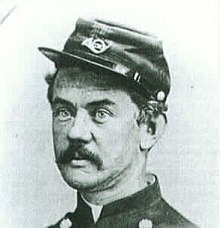
Frederick Benteen
History is not only changed in the name from Benteen to Benton, but also the facts about Benteen. According to the motion picture Benton attempts to warn Custer of a mass build up he discovered of Sioux, but the General doesn't listen. When the flashback ends the Board of Inquiry clears Reno.

Marcus Reno
Once more history is revised by Salkow. What is missing in the motion picture is the fact that the Board of Inquiry never stated Reno was cleared of the charges. Just that they would not sustain those charges.
"The Great Sioux Massacre" was nothing for inaccuracies compared to 1967's "Custer of the West" starring Robert Shaw as George Armstrong Custer.
To begin with the motion picture was shot for Cinerama which meant you ride with two soldiers tied to their wagon by the Sioux as it rolls down a whining road until it goes over a cliff and other staged shots for the film process.
Then there is the story that claims to tell the story of the Little Big Horn from both points of view, but as with the Errol Flynn movie is making Custer out as a National hero who attempted to protect the Sioux. While also attempting to make the Sioux sympathetic. Besides British actor Robert Shaw as Custer. You have British actor Kieron Moore identified in the credits as Sitting Bull, but his character's name is never mentioned in Bernard Gordon and Julien Zimet's script. A script that seems to have been written 26 years before for the Flynn film as there are scenes right out of that motion picture. Also Scottish actress Mary Ure plays Custer's wife.
Of course there are no Native American's in the cast as the film was shot in Spain. As the movie was an American funded production filling in other roles near the end of their careers were Ty Hardin as Reno and Jeffrey Hunter as Benteen. Robert Ryan also appears in the film as a drunken Sergeant who keeps going over the hill to search for gold.
The climatic battle is pure historical inaccuracy and flag waving.
In 1984 Evan Connell wrote a non-fiction work, but used a narrative style of fiction by having the story told by two women. The first was Elizabeth Custer the wife of George Armstrong Custer and the second was a fictional Sioux women named Kate Bighead. In this format Connell related the events leading up to and after "The Little Big Horn" told from both sides of the issue. In 1991 the book was made into a two television part mini-series of the same name.
Playing Custer was Gary Cole, Elizabeth Custer was played by Rosanna Arquette, the part of Kate Bighead was played by Kimberly Guerrero but her voice was provided by Canadian Cree Singer/Writer Buffy Saint-Marie, Crazy Horse was played by Omaha Rodney A, Grant, Red Cloud by Blackfoot actor Nick Ramus, Sioux Musician Floyd Red Crow Westerman played Sitting Bull.
The novel and mini-series besides dealing with the Little Big Horn shows the events of both the Fetterman Fight, when Lakota, Cheyenne and Arapaho Indians killed Captain William J. Fetterman and his 81 men, and the Battle of Washita River, an attack on Chief Black Kettle's encampment by Custer and the 7th Calvary, which occurred prior to Custer's death.
https://en.wikipedia.org/wiki/Fetterman_Fight
https://en.wikipedia.org/wiki/Battle_of_Washita_River
Both the book and the mini-series attempt a balanced look at all three events through the eyes of the two women narrating.
All of this brings me back to director John Ford and his 1948 motion picture and the first of his Cavalry trilogy "Fort Apache". Which is in reality a look at General George Armstrong Custer as a egotistical megalomaniac. However, Ford moves the story out of the Dakota's to Arizona and changes the Sioux, Cheyenne and Arapaho into Apache's. While Custer morphs into Lieutenant Colonel Owen Thursday played beautifully by Henry Fonda. All this allowing John Ford to comment upon the "Custer Mythos".
Ford as I have previously mentioned is considered by some to be racist towards Indians. It is interesting then to look at this film as designed by him. One important element is by substituting location, names of the U.S. Army personnel and Apache's for the Sioux and other Nations involved in the Little Big Horn. John Ford was able as no other producer with his partner Merian C. Cooper, or director do. Tare apart the Custer Mythos and show the Indians as not the villains of the piece. Thursday is not the heroic Errol Flynn, or even Robert Shaw. He hates the Apache and will not admit he does not understand them. He knows how they should be treated without listening to officers who have been in Arizona years longer than his few days. The man believes that the only good Indian is a dead Indian.
If this poster didn't tell the potential audience they were seeing a revision of "Custer's Last Stand".

Then when they saw "Thursday's Last Stand" the positioning of the actors by Ford did.
The motion picture ends as if this wasn't enough with a group of the press talking to Shirley Temple who played Thursday's daughter, John Wayne the new commanding officer of Fort Apache and John Agar. They are looking at a painting hanging on the wall that other than substituting the image of Henry Fonda is an exact duplicate of one of the better known of "Custer's Last Stand". They remark how gallantly Thursday died for his country. Custer may have died for our sins, but Thursday died for Hollywood and their image of Native Americans.
The last film I will speak too is of course Kevin Costner's "Dances with Wolves" from 1990. The simple story of a Calvary officer Lieutenant John Dunbar in 1863 who is wounded and cited for bravery during the Civil War. He requests a transfer to a Western Post. The post is in the middle of nowhere and he is the only one there. The only person who knew where he was sent is killed in a Pawnee raid leaving Dunbar isolated from the Army. Who has forgotten him.
He first encounters the Sioux as they attempt to steal his horse several times, but neither can communicate with each other resulting in nothing being settled and confusion. Dunbar decides to go to the Sioux and attempt to once more speak with them On his way there he sees "Stands with a Fist" who is attempting to commit suicide after loosing her husband. He stops her and takes her back to the Sioux. "Stands with a Fist" was a white captive and is also the adopted daughter of the tribes Medicine Man "Kicking Bird". Thus with her help Dunbar starts to bridge the cap between his language and the Sioux. While learning the way of the Lakota and how to survive in this land.
This motion picture finally accomplishes two things and this may be, because Costner's film was really an independent project. The first is using Native American and Canadian Indian tribe actors only cast as the Sioux. The exception being Mary McDonnell logically as "Stands with a Fist". "Kicking Bird" is played by Graham Greene of the Onieda from Canada. Where he was born on the Six Nations Reservation in Ontario. The other main Indian character is "Wind in his Hair" played by Rodney A. Grant who was raised on the Omaha reservation in Macy, Nebraska.
With an all Indian cast speaking Lakota Sioux. With an on set Lakota language instructor to check pronunciation in Doris Leader Charge who also played "Pretty Shield" and the subtitles prepared for accuracy by Albert White Hat the chair of Sinte Gieska University. A four year American tribal Indian college. You would finally think "Dances with Wolves", as some expressed, the perfect Native American depiction after all those Hollywood motion pictures.
Well I guess not.
When the late actor and Native American activist Russell Means an Ogala Lakota and some of his friends saw "Dances with Wolves" they had a few problems. In a 2009 interview with Dan Ske of "High Times", exact date unknown, Means remarked:
Remember Lawrence of Arabia? That was Lawrence of the Plains. The odd thing about making that movie is that they had a woman teaching the actors the Lakota language, but Lakota has a male-gendered language and a female-gendered language. Some of the Indians and Kevin Costner were speaking in the feminine way. When I went to see it with a bunch of Lakota guys, we were laughingWhile Michael Smith a Sioux and director of "San Francisco's American Indian Film Festival" in 2005 expressed this viewpoint:
There's a lot of good feeling about the film in the Indian community, especially among the tribes. I think it's going to be very hard to top this one.The motion picture was nit picked to death including comments about the Native American non-Lakota actors, which included other Sioux tribes, mispronouncing the words correctly. It would seem that even an honest attempt at portraying the Native American experience can not succeed.
The 2013 film "The Lone Ranger" did not go without controversy over using Johnny Depp as Tonto. Depp stated he believes there is Native American blood in his Grandmother's ancestry and Todd McDaniels a linguist at the "Comanche Nation College" believes Depp did a very good job when he was attempting to speak the Comanche language of the character Tonto. So the debate on how Hollywood portrays Native American's still goes on.
Then there was my youth and "Princess Sumerfallwinterspring" of Doodyville. "The Howdy Doody Show" started in 1947 one year after I was born. I was about four in 1950 when I became aware of it. My first experience with Native Americans was through "Princess Summerfallwinterspring"
She was played by a young white actress named Judy Taylor. Who was four year old Lloyd to doubt she wasn't a real Indian? "Princess Summerfallwinterspring taught me Indians were nice people to know and fun, Even her father Chief Thunderthud of the Ooragnak Indians started out mean, but became good nature and funny. Their tribe name was Kangaroo spelled backwards.Yes these were parodies of Native American's just as the show's host "Buffalo Bob Smith" was one of "Buffalo Bill". Then there was the misery "Mr. Bluster" and of course the boy in the cowboy outfit "Howdy Doody". These last two marionettes. The show was fun with children sitting in "The Peanut Gallery" and the viewers at home all enjoying it, but there were moral lessons to learned. No intent to harm the Native American culture was meant in it, but in was the 1950's and stereo types unfortunately persisted as they still do today.
Sadly, later in her career after filming "Jailhouse Rock" with Elvis Presley. Judy Taylor and her husband were killed in a car accident. She never saw the finished movie.
At the same time as I was watching my false Native American Princess. There was "The Tim McCoy Show" on KTLA with real Native American "Iron Eyes" Cody, or at least at the time I thought he was a real Indian. That program balanced the other in my mind and it is a shame more like it were not on television educating about the Native American experience. The point here was even though they were portrayed not by real Native Americans my first impressions were of peaceful and interesting people and I kept it that way as did others,
In the 1970's "Black" actors and producers decided to make motion pictures for themselves and release them. Two unexpected results occurred when films with such titles as "Black Caesar", "Cleopatra Jones", "Blackula" and yes "Shaft" came out. Instead of just the "Back" community seeing these pictures as planned. They attracted a mainstream white audience first of college age and then older and younger. Next the "Studios" who were still ignoring "Black" talent discovered Richard Roundtree, Pam Grier and William Marshall who was a major Shakespearean actor known for his "Othello", Marshall had been in films for three decades. The barrier went down. Perhaps, if I am permitted to suggest, it is time for Native Americans to do the same on the same scale. Somebody has to tell the real other side to "The Battle of Apache Pass", or "Sand Creek".



.jpg)


No comments:
Post a Comment